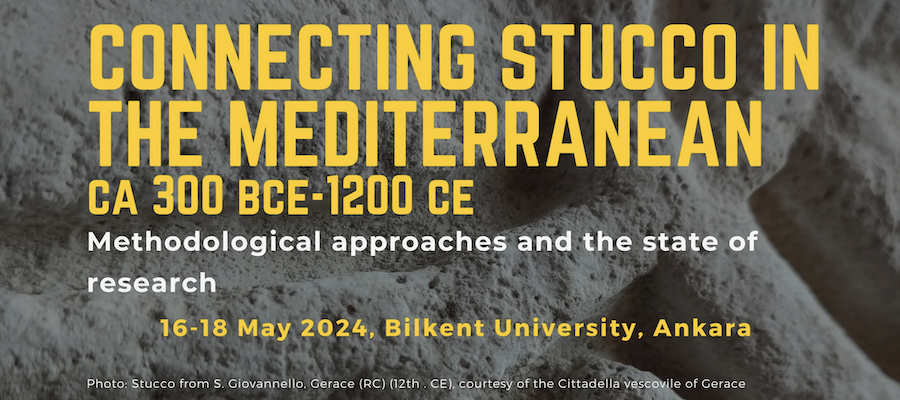Connecting Stucco in the Mediterranean (c. 300 BCE–1200 CE): Methodological Approaches and the State of Research, Bilknet University, May 16–18, 2024
The use of plaster reliefs (stuccoes) as architectural decoration is a well-known phenomenon in the Mediterranean, with roots already in ancient Egyptian architecture. However, it has been mainly studied within the boundaries of specific disciplines and chronological specialisations. While this allowed scholars to recognise the relationship of stucco with specific architectural traditions and technologies, it did not allow to spot long-term trends and cross-cultural interactions. This is due to the lack of coordination of scholarship on the study of stucco, which appears to develop at different speeds and aim at different goals depending on the field of study. For example, in the field of Islamic art and archaeology, stucco has mainly been studied in terms of stylistic and iconographic aspects in order to spot cultural exchanges within the Islamicate world; the technological aspect has only recently started to be addressed with archaeometric analyses. At the same time, research on Western Medieval stuccoes benefitted from a more holistic approach, which started to answer the changes in iconography, style, and technologies from the Late Antique to the Early Medieval period. However, the last comprehensive publications on the subject date to the early 2000s and little has been done since then, especially on the archaeometric analyses and their interpretation. The study of stucco makers, their legal and social status have been analysed for Roman stucco and partially for the Western Medieval world, while it is largely missing for the other fields of study on stucco in the period of interest here. The knowledge of Byzantine stucco is still in its infancy, lacking archaeometric analysis and not going beyond the single case studies, except for a limited number of studies.
Despite this dispersed character of research on stucco, many important studies on this material have been produced in the recent decades and the academic community has had multiple occasions to discuss stucco at various conferences and workshops. Therefore, we feel it is time to connect these efforts and address common questions that can help to see long-term phenomena and cross-cultural exchanges in the Mediterranean.
We encourage papers submission on the following (but not exclusively) topics:
- Technology and makers: what do we know about the technology of stucco production and how it differed in various regions and throughout time? Did technological advances spread from one region to another? Who were the stucco workers? What was their place in past societies, and how did their status change through time?
- Patterns of transmission: to what extent did stucco workshops, styles, iconographic motifs, and formal features overcome geographical, political, and confessional boundaries? How knowledge about stucco-making was transmitted? What was the relationship between stucco produced in the Mediterranean with stucco traditions of other regions, such as the wider Iranian world?
- Perception by past societies: What was the perception of stucco by past societies? How did people perceive it in relation to marble and other media? Was it perceived as a material worthy of preservation? Was it considered a cheap material?
- Stucco and modern discipline boundaries: does stucco production fit modern boundaries of academic discourse? For example, do we have “Byzantine” and “Islamic” stucco production? How does it relate to other materials (marble, limestone, wood), and what do we know about workshops? Did stuccoists work alongside stone sculptors, whitewashers, and/or painters?
- The state of studies: What is the place of research on stucco in modern academia? What are the practices related to excavations, displays, publishing, etc.? Does it have a place on its own, or is it seen as a part of studies on sculpture or architectural decoration? What are the methodological approaches used to date and study stucco?
- We encourage an in-person presence to facilitate the discussion and dissemination of knowledge, even though the conference will be available in hybrid form.
The language of the conference is English.
Organisers: Dr Agnieszka Lic (Polish Academy of Sciences), Dr Flavia Vanni (Università degli Studi di Salerno) and Dr Luca Zavagno (Bilkent University)
